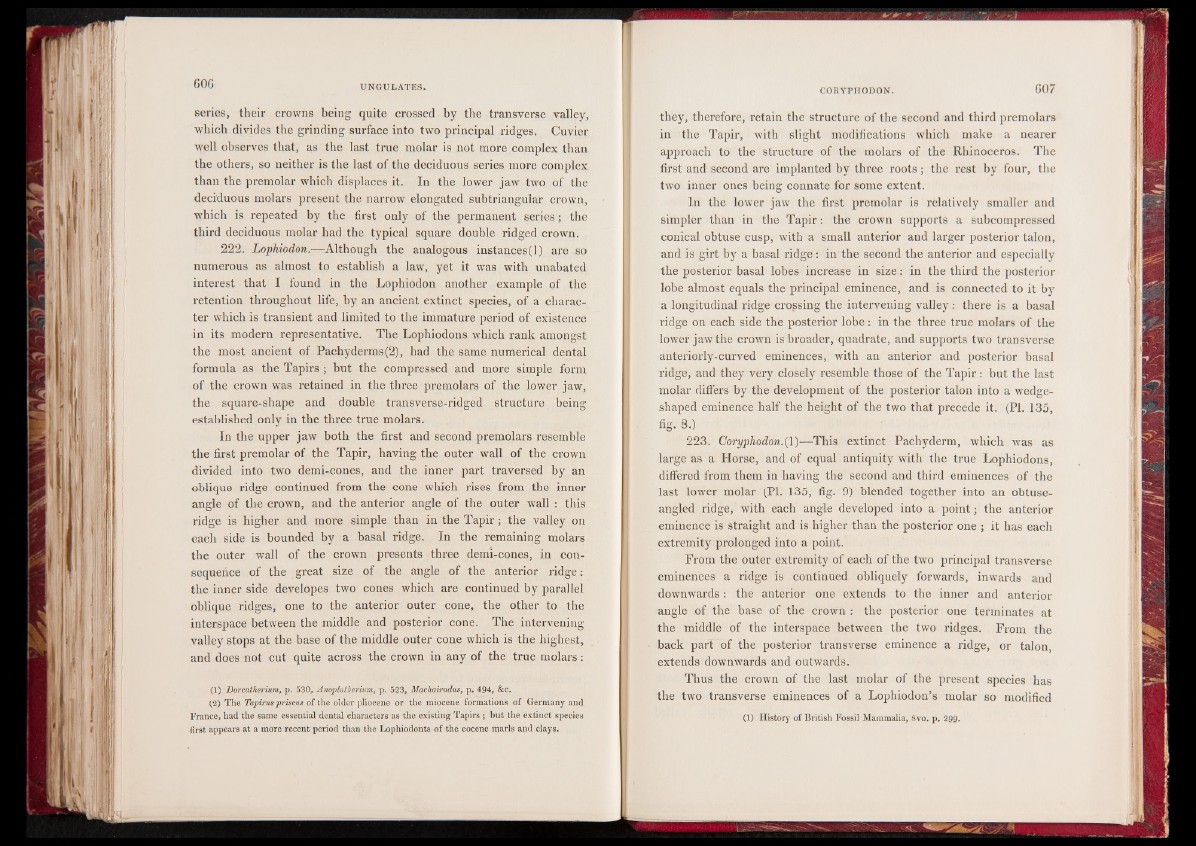
series, their crowns being quite crossed by the transverse valley,
which divides the grinding surface into two principal ridges. Cuvier
well observes that, as the last true molar is not more complex than
the others, so neither is the last of the deciduous series more complex
than the premolar which displaces it. In the lower jaw two of the
deciduous molars present the narrow elongated subtriangular crown,
which is repeated by the first only of the permanent series; the
third deciduous molar had the typical square double ridged crown.
222. Lophiodon.—Although the analogous instances(l) are so
numerous as almost to establish a law% yet it was with unabated
interest that I found in the Lophiodon another example of the
retention throughout life, by an ancient extinct species, of a character
which is transient and limited to the immature period of existence
in its modern representative. The Lophiodons which rank amongst
the most ancient of Pachyderms(2), had the same numerical dental
formula as the Tapirs ; hut the compressed and more simple form
of the crown was retained in the three premolars of the lower jaw,
the square-shape and double transverse-ridged structure being
established only in the three true molars.
In the upper jaw both the first and second premolars resemble
the first premolar of the Tapir, having the outer wall of the crown
divided into two demi-cones, and the inner part traversed by an
oblique ridge continued from the cone which rises from the inner
angle of the crown, and the anterior angle of the outer wall : this
ridge is higher and more simple than in the Tapir; the valley on
each side is bounded by a basal ridge. In the remaining molars
the outer wall of the crown presents three demi-cones, in consequence
of the great size of the angle of the anterior ridge:
the inner side developes two cones which are continued by parallel
oblique ridges, one to the anterior outer cone, the other to the
interspace between the middle and posterior cone. The intervening
valley stops at the base of the middle outer cone which is the highest,
and does not cut quite across the crown in any of the true molars: 1 2
(1) Dorcatherium, p. 530, Anoplolherium, p. 523, Machairodus, p. 494, &c.
(2) The Tapirus prisms of the older pliocene or the miocene formations of Germany and
France, had the same essential dental characters as the existing Tapirs ; but the extinct species
first appears at a more recent period than the Lophiodonts of the eocene marls and clays.
they, therefore, retain the structure of the second and third premolars
in the Tapir, with slight modifications which make a nearer
approach to the structure of the molars of the Rhinoceros. The
first and second are implanted by three roots; the rest by four, the
two inner ones being connate for some extent.
In the lower jaw the first premolar is relatively smaller and
simpler than in the Tapir: the crown supports a subcompressed
conical obtuse cusp, with a small anterior and larger posterior talon,
and is girt by a basal ridge: in the second the anterior and especially
the posterior basal lobes increase in size: in the third the posterior
lobe almost equals the principal eminence, and is connected to it by
a longitudinal ridge crossing the intervening valley : there is a basal
ridge on each side the posterior lobe: in the three true molars of the
lower jaw the crown is broader, quadrate, and supports two transverse
anteriorly-curved eminences, with an anterior and posterior basal
ridge, and they very closely resemble those of the Tapir: but the last
molar differs by the development of the posterior talon into a wedge-
shaped eminence half the height of the two that precede it. (PI. 135,
fig. 8.)
223. CorypAodon.(l)ffl-This extinct Pachyderm, which was as
large as a Horse, and of equal antiquity with the true Lophiodons,
differed from them in having the second and third eminences of the
last lower molar (PI. 135, fig. 9) blended together into an obtuse-
angled ridge, with each angle developed into a point; the anterior
eminence is straight and is higher than the posterior one ; it has each
extremity prolonged into a point.
From the outer extremity of each of the two principal transverse
eminences a ridge is continued obliquely forwards, inwards and
downwards: the anterior one extends to the inner and anterior
angle of the base of the crown : the posterior one terminates at
the middle of the interspace between the two ridges. From the
back part of the posterior transverse eminence a ridge, or talon
extends downwards and outwards.
Thus the crown of the last molar of the present species has
the two transverse eminences of a Lophiodon’s molar so modified
(1) History of British Fossil Mammalia, 8vo. p. 299.